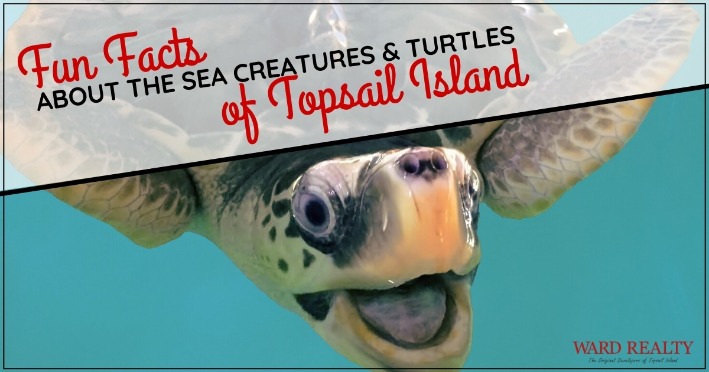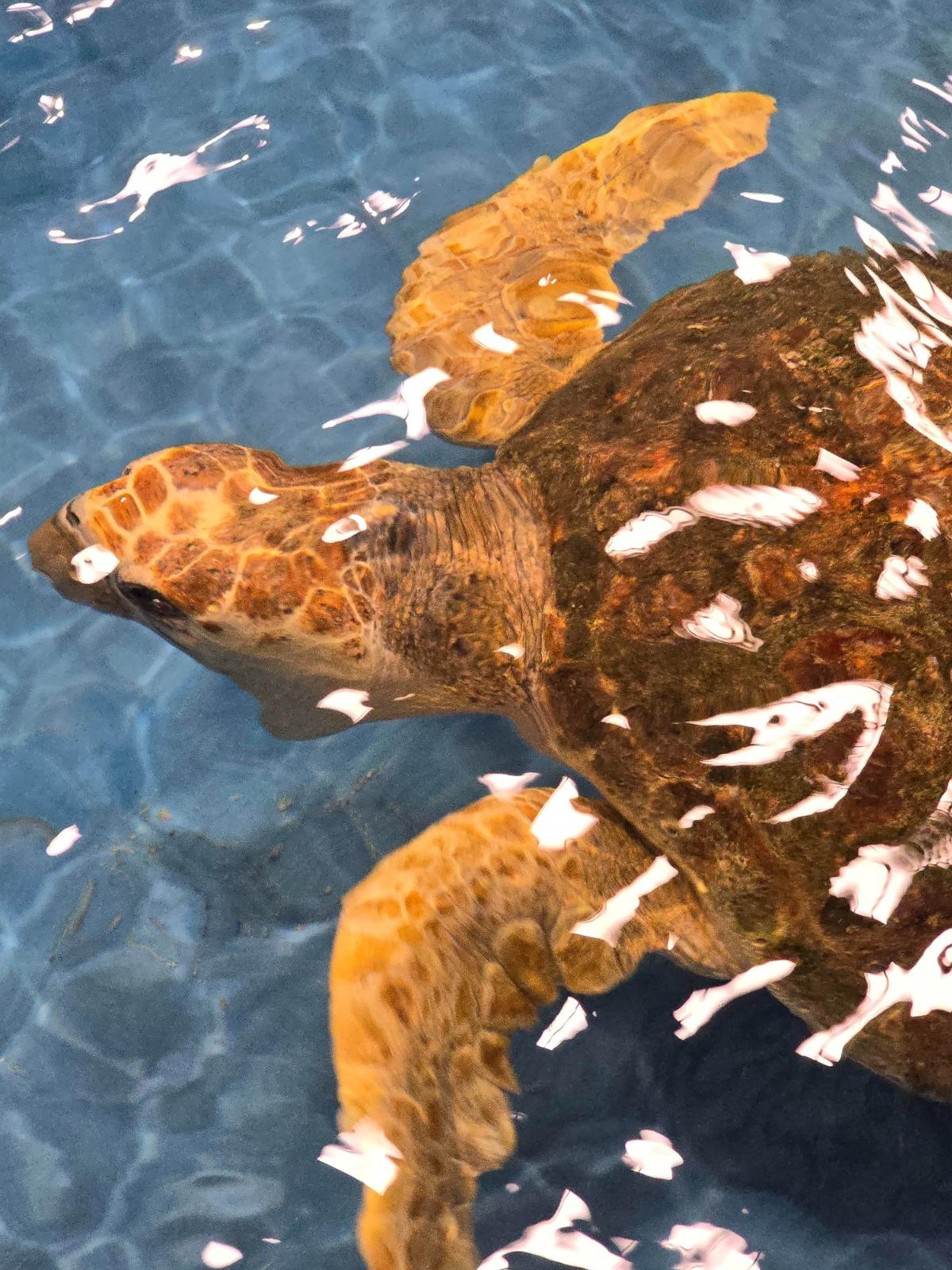
One of the best parts about exploring a new vacation destination is learning all about the local wildlife.
Here on Topsail Island, we are so lucky to have a diverse collection of both sea life and land animals to discover. We are probably most famous for our adorable sea turtles, but there are many other animals here that will fascinate and delight your group.
Here are some fast, fun facts about the sea creatures found on Topsail Island. To kick it off, we interviewed Terry Meyer from the Karen Beasley Sea Turtle Rescue and Rehabilitation Center of Surf City. It's been a great year for our sea turtles!
Sea Turtles
The most notorious residents on the Carolina coast are the sea turtles - specifically - the glorious Loggerhead Sea Turtle.
We are so lucky that Terry Meyer (volunteer & board member of the Karen Beasley Sea Turtle Rescue) agreed to speak with us today.

2019 was nearly a record-setting year for sea turtle nests. The rescue tracked 179 nests (the highest on record was 181, back in 1999). Terry noted that any number over 100 is GREAT, but they have seen as few as 50 nests in a breeding season. Luckily, these numbers appear to be holding steady which is great news for our sea turtles.
What factors are contributing to this uptick? Well, Terry sure hopes and believes that their work has something to do with it (did you know that volunteers check on the nests EVERY SINGLE DAY during breeding season?).
Topsail Island has 26 miles of coastline. Each mile is surveyed every morning to identify sea turtle tracks and nests from May through August.
- Karen Beasley Sea Turtle Rescue
The Rescue first started tracking turtle nests back in 1990, and turtles don't start breeding until they reach 25-30 years of age. According to our calculations, the good work these volunteers do (educating the public, marking off turtle nests, protecting nesting areas and replenishing the dunes and sand) is working! We are just now seeing the fruits of these conservation measures.
Another factor that might lead to more nests is the fact that sea turtle breeding is cyclical. Sea turtles nest 4-5 times every season, but only every 2-3 years. It's possible we are simply in a "high point" of the breeding cycle.
Terry was excited to report that the Karen Beasley Rescue is part of a 3-state study that studies the DNA of turtle eggs. Now in its 10th year, the study involves saving one egg from each sea turtle nest and extracting the DNA. This has provided the organization with very rich data about the health, genetics and patterns of our sea turtles, which only helps the rescue understand them more.
Visit the Sea Turtle Hospital
HOURS: Open for tours on Thursdays and Saturdays from 1-4pm (check website for seasonal hours and holiday closings).
ADMISSION (plus tax): $3 Children (12 and under), $4 Seniors & Military, $5 General Admission (13 and up)
302 Tortuga Lane, Surf City, NC 28445
910-329-0222
Terry said that the most rewarding part of her job at the Sea Turtle Rescue is the connection the volunteers make with the public. Unsuspecting visitors or vacationers will stumble upon a turtle nest while volunteers are on duty, and that's when they have the chance to make a connection.
Often, the same families will return year after year to check up on their favorite turtles at the rescue, and many children have sent back photos of their sea turtle-inspired science projects. We have to wonder how many future scientists, biologists and rehabilitators are kicking off their entire future based on a simple visit to Topsail Island?
More fun facts about the sea creatures of Topsail Island:
The ocean is absolutely fascinating. Did you know that the average depth of the ocean is over 12,000 feet? We see only a fraction of the ocean's vast sealife from the sunny shore, but here are a few of the animals you might spot when you visit Topsail Island, North Carolina.
Whales swim by Topsail Island every winter!
We have seen a bit of a whale frenzy lately. Sightings of what are probably Humpback or Right Whales have been frequent and spectacular this winter! Whales pass by our coast to head to warmer waters during the winter months. We see them again in the spring as they head back north!
Manatees hang out here, too.
Only traveling as far north as NC during the summer months, manatees have been spotted with greater frequency in recent years. Possibly because their usual home off the Florida coast is getting too warm, or maybe because the manatee population has grown so they need more spots to feed and breed. Either way, it's always a delight to spot a sea cow near our docks.
There are at least 10 species of stingray in NC.
Commonly found in our North Carolina waters (shuffle your feet as you walk in the ocean to avoid stepping on them!) ... rays are the scavengers of the ocean! They will take care of dead or sick animals, and are an important part of the ecosystem.
Dead jellyfish can still sting you!
If you spot a "bloom" (a large cluster of jellyfish), just stay out of the water. Our local jellyfish don't pack much of a punch, but it's still best to avoid these brainless blobs as they float along.
There are up to 73 species of sharks around here.
You aren't likely to encounter one, and most are not dangerous to humans. Just don't go too deep, and if you see fins, take a break from the ocean!
Ghost crabs can change color depending on their environment.
They are fast, too! Hunting ghost crabs is a fun evening activity for the whole family. Grab a few flashlights and a bucket, then head to the place where the water hits the sand. You will see their little air holes and they congregate in groups.
Sea urchins have teeth.
Hard to picture, isn't it? They need teeth to scrape their food (algae, seaweed, and some small animals) off the rocks on which they live.
Sand dollars are alive.
If you find a sand dollar that is purplish in color and covered in little hairs, put him back in the ocean! He is still alive. If you find one that is bleached white from the sun and hairless, you can add him to your shell collection (it's not a shell, but it sure is pretty).
Topsail has porpoises AND dolphins.
How do you tell the difference? Dolphins have a pointier beak and are longer and leaner. Porpoises are a little more, well, chunky... and have a rounder, smaller nose. Read more about them both here.
This is just a sampling of the animals you might see while on your Topsail Island vacation. We didn't even mention the hundreds of varieties of fish, shelled animals like oysters and crabs, or ocean-loving birds like seagulls, black skimmers, terns, pelicans and ospreys! Come visit and see for yourself.
Need a vacation rental? Call Ward Realty and we are happy to help you start planning.
What wildlife have you encountered on topsail island?
Share your photos and stories with our readers.




